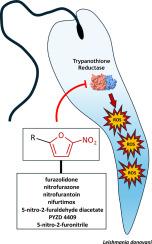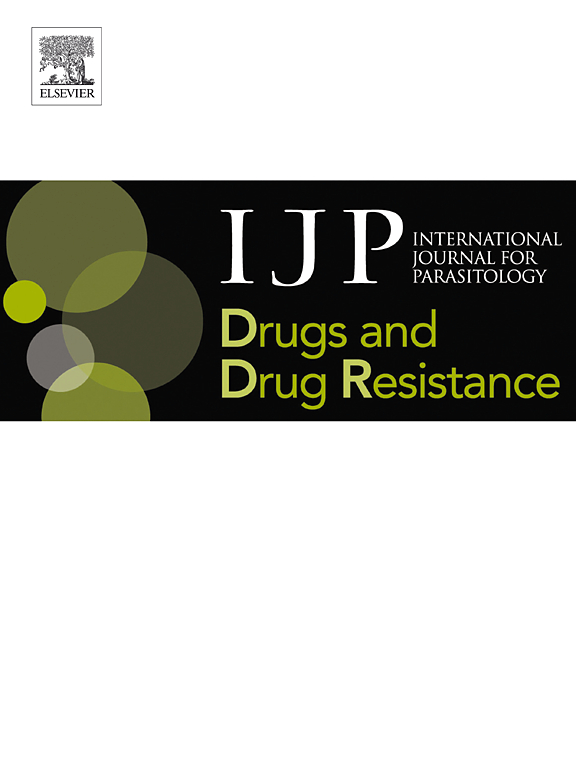Mechanistic, in-silico and in vitro studies with nitrofurans reveal potent leishmanicidal activity and inhibition of trypanothione reductase
IF 3.4
2区 医学
Q1 PARASITOLOGY
International Journal for Parasitology: Drugs and Drug Resistance
Pub Date : 2025-08-01
DOI:10.1016/j.ijpddr.2025.100605
引用次数: 0
Abstract
Visceral leishmaniasis caused by Leishmania infantum and Leishmania donovani is one of the neglected tropical diseases (NTDs) caused by trypanosomatids with treatment options limited to outdated drugs often causing adverse effects and promoting drug resistance. Previous antileishmanial drug discovery campaigns have identified nitroheterocyclic molecules with high efficacy and a high selectivity index. Therefore, we have evaluated on our screening platform of fluorescent L. donovani amastigotes, the antileishmanial activity of seven nitrofuran derivatives: furazolidone, nitrofurazone, nitrofurantoin, nifurtimox, 5-nitro-2-furaldehyde diacetate, PYZD-4409 and 5-nitro-2-furonitrile. These compounds showed good efficacy against axenic and intramacrophage amastigotes, most of them showing low cytotoxicity in mammalian cell lines. These nitrofuran derivatives induced reactive oxygen species production in axenic amastigotes and inhibited trypanothione reductase (TryR) either in uncompetitive or competitive manner, thus suggesting that their mechanism of action involves increased oxidative stress caused by an imbalance in redox metabolism. Furazolidone exhibited the most promising antileishmanial profile, and molecular docking analysis revealed consistency with the strongest TryR uncompetitive inhibitory effect, demonstrating its high affinity for an alternative binding site near the substrate (oxidized trypanothione) pocket. Docking results also highlighted PYZD-4409 as the compound with the highest binding affinity, and showed consistency with its competitive inhibition mechanism. Furthermore, similar binding modes identified across L. donovani TryR and other homologous proteins suggest the potential broad-spectrum activity of these nitrofuran derivatives, thus underscoring their importance as promising candidates for the development of novel antileishmanial therapies with broad-spectrum applications.

对硝基呋喃的机械、计算机和体外研究表明,它具有强大的利什曼尼杀灭活性和对锥虫硫酮还原酶的抑制作用
由婴儿利什曼原虫和多诺瓦利什曼原虫引起的内脏利什曼病是由锥虫虫引起的被忽视的热带病之一,治疗选择仅限于过时的药物,往往造成不良反应并促进耐药性。以往的抗利什曼原虫药物发现活动已经确定了具有高效和高选择性指数的硝基杂环分子。因此,我们在我们的荧光多诺瓦氏L. amastigotes筛选平台上,对呋喃酮、呋喃酮、呋喃妥英、呋喃替莫、5-硝基-2-呋喃醛二乙酸酯、PYZD-4409和5-硝基-2-呋喃腈7种呋喃衍生物的抗利什曼原虫活性进行了评价。这些化合物对无性系和巨噬细胞内无性系均有良好的抑制作用,多数在哺乳动物细胞系中表现出较低的细胞毒性。这些硝基呋喃衍生物诱导无源无尾线虫产生活性氧,并以非竞争或竞争的方式抑制锥体硫酮还原酶(TryR),从而表明它们的作用机制与氧化还原代谢失衡引起的氧化应激增加有关。呋喃唑酮显示出最有希望的抗利什曼原虫特征,分子对接分析显示其与最强的TryR非竞争性抑制效果一致,表明其对底物(氧化锥虫硫酮)口袋附近的替代结合位点具有高亲和力。对接结果也显示PYZD-4409是结合亲和力最高的化合物,与其竞争抑制机制一致。此外,在L. donovani TryR和其他同源蛋白中发现的类似结合模式表明,这些硝基呋喃衍生物具有潜在的广谱活性,因此强调了它们作为开发具有广谱应用的新型抗利什曼病治疗方法的有希望的候选物的重要性。
本文章由计算机程序翻译,如有差异,请以英文原文为准。
求助全文
约1分钟内获得全文
求助全文
来源期刊

International Journal for Parasitology: Drugs and Drug Resistance
PARASITOLOGY-PHARMACOLOGY & PHARMACY
CiteScore
7.90
自引率
7.50%
发文量
31
审稿时长
48 days
期刊介绍:
The International Journal for Parasitology – Drugs and Drug Resistance is one of a series of specialist, open access journals launched by the International Journal for Parasitology. It publishes the results of original research in the area of anti-parasite drug identification, development and evaluation, and parasite drug resistance. The journal also covers research into natural products as anti-parasitic agents, and bioactive parasite products. Studies can be aimed at unicellular or multicellular parasites of human or veterinary importance.
 求助内容:
求助内容: 应助结果提醒方式:
应助结果提醒方式:


